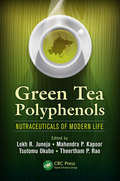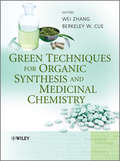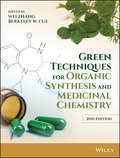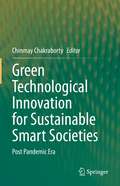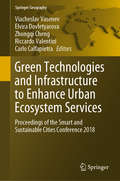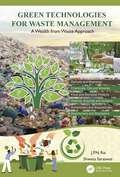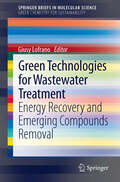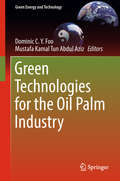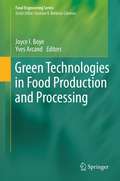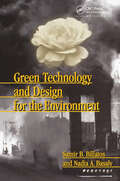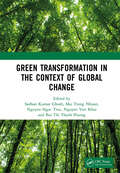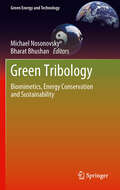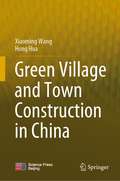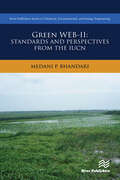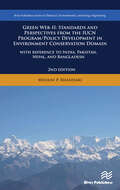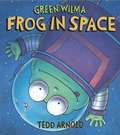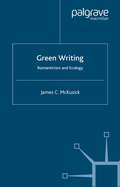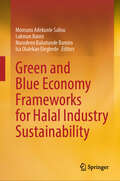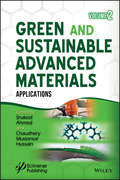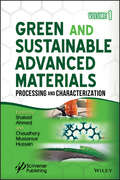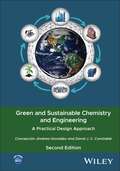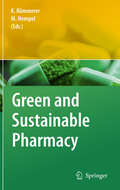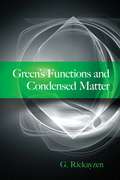- Table View
- List View
Green Tea Polyphenols: Nutraceuticals of Modern Life
by Lekh R. Juneja Mahendra P. Kapoor Tsutomu Okubo Theertham P. RaoThere is a wealth of published research on the health-promoting effects of green tea and its various components including polyphenols. Green Tea Polyphenols: Nutraceuticals of Modern Life presents a collection of global findings on the numerous health benefits of green tea polyphenols, confirming their position as healthy functional ingredients. Wi
Green Techniques for Organic Synthesis and Medicinal Chemistry
by Wei Zhang Berkeley CueGreen chemistry is a new way of looking at organic synthesis and the design of drug molecules, offering important environmental and economic advantages over traditional synthetic processes. Pharmaceutical companies are increasingly turning to the principles of green chemistry in an effort to reduce waste, reduce costs and develop environmentally benign processes.Green Techniques for Organic Synthesis and Medicinal Chemistry presents an overview of the established and emerging techniques in green organic chemistry, highlighting their applications in medicinal chemistry. The book is divided into four parts:Introduction: Introduces the reader to the toxicology of organic chemicals,their environmental impact, and the concept of green chemistry.Green Catalysis: Covers a variety of green catalytic techniques including organocatalysis, supported catalysis, biocatalysis, fluorous catalysis, and catalytic direct C-H bond activation reactions.Green Synthetic Techniques: Presents a series of new techniques, assessing the green chemistry aspects and limitations (i.e. cost, equipment, expertise). Techniques include reactions in alternative solvents, atom economic multicomponent reactions, microwave and ultrasonic reactions, solid-supported synthesis, fluorous and ionic liquid-based recycling techniques, and flow reactors.Green Techniques in Pharmaceutical Industry: Covers applications of green chemistry concepts and special techniques for medicinal chemistry, including synthesis, analysis, separation, formulation, , and drug delivery. Process and business case studies are included to illustrate the applications in the pharmaceutical industry.Green Techniques for Organic Synthesis and Medicinal Chemistry is an essential resource on green chemistry technologies for academic researchers, R&D professionals and students working in organic chemistry and medicinal chemistry.
Green Techniques for Organic Synthesis and Medicinal Chemistry
by Wei Zhang Berkeley W. CueAn updated overview of the rapidly developing field of green techniques for organic synthesis and medicinal chemistry Green chemistry remains a high priority in modern organic synthesis and pharmaceutical R&D, with important environmental and economic implications. This book presents comprehensive coverage of green chemistry techniques for organic and medicinal chemistry applications, summarizing the available new technologies, analyzing each technique’s features and green chemistry characteristics, and providing examples to demonstrate applications for green organic synthesis and medicinal chemistry. The extensively revised edition of Green Techniques for Organic Synthesis and Medicinal Chemistry includes 7 entirely new chapters on topics including green chemistry and innovation, green chemistry metrics, green chemistry and biological drugs, and the business case for green chemistry in the generic pharmaceutical industry. It is divided into 4 parts. The first part introduces readers to the concepts of green chemistry and green engineering, global environmental regulations, green analytical chemistry, green solvents, and green chemistry metrics. The other three sections cover green catalysis, green synthetic techniques, and green techniques and strategies in the pharmaceutical industry. Includes more than 30% new and updated material—plus seven brand new chapters Edited by highly regarded experts in the field (Berkeley Cue is one of the fathers of Green Chemistry in Pharma) with backgrounds in academia and industry Brings together a team of international authors from academia, industry, government agencies, and consultancies (including John Warner, one of the founders of the field of Green Chemistry) Green Techniques for Organic Synthesis and Medicinal Chemistry, Second Edition is an essential resource on green chemistry technologies for academic researchers, R&D professionals, and students working in organic chemistry and medicinal chemistry.
Green Technological Innovation for Sustainable Smart Societies: Post Pandemic Era
by Chinmay ChakrabortyThis book discusses the innovative and efficient technological solutions for sustainable smart societies in terms of alteration in industrial pollution levels, the effect of reduced carbon emissions, green power management, ecology, and biodiversity, the impact of minimal noise levels and air quality influences on human health. The book is focused on the smart society development using innovative low-cost advanced technology in different areas where the growth in employment and income are driven by public and private investment into such economic activities, infrastructure and assets that allow reduced carbon emissions and pollution, enhanced energy, and resource efficiency and prevention of the loss of biodiversity and ecosystem services. The book also covers the paradigm shift in the sustainable development for the green environment in the post-pandemic era. It emphasizes and facilitates a greater understanding of existing available research i.e., theoretical, methodological, well-established and validated empirical work, associated with the environmental and climate change aspects.
Green Technologies and Infrastructure to Enhance Urban Ecosystem Services: Proceedings of the Smart and Sustainable Cities Conference 2018 (Springer Geography)
by Riccardo Valentini Carlo Calfapietra Elvira Dovletyarova Viacheslav Vasenev Zhongqi ChengThese proceedings of the Smart and Sustainable Cities Conference (SSC) in Moscow from May 23 to 26, 2018 addresses important questions regarding the global trend of urbanization. What are the environmental consequences of megacities’ expansion? What smart solutions can make life in cities safe, comfortable and environmentally friendly? It is projected that 70% of the global population will live in cities by 2050, and as such the book describes how this rapid urbanization will alter the face of the world. Focusing on solutions for the environmental problems of modern megapolises, it discusses advanced approaches and smart technologies to monitor, model and assess the environmental consequences and risks. The contributors present examples of successful sustainable urban development, including management and design of green infrastructure, waste management, run-off purification and remediation of urban soils. The SSC conference and its proceedings offer a valuable contribution to sustainable urban development, and are of interest to the scientific and research community, municipal services, environmental protection agencies, landscape architects, civil engineers, policy makers and other stakeholders in urban management and greenery.
Green Technologies for Industrial Waste Remediation (Environmental Science and Engineering)
by Neeraj Kumar Singh Soumya Pandit Abhilasha Singh MathuriyaThis proposed book chapter is expected to provide the readers with wide aspects of green technologies for industrial waste remediation. The first chapter is dedicated to the introduction to the title of the book. The chapter discusses various green technologies for industrial waste remediation. After that, the second chapter emphasizes the different types of applications of microorganisms in industrial waste treatment. After that, chapters emphasize the specific area of the title, including the micro and nanofiltration technology for the treatment of industrial wastewater, methods for the recovery and removal of heavy metals from industrial effluents, algal photobioreactor technology for industrial wastewater treatment, carbon capture and energy recovery, bioremediation of radioactive wastes, membrane-based technologies for industrial waste management, valorization of agro-industrial wastes for biorefinery products, bioaccumulation and detoxification of metals through genetically engineered microorganism, application of biochar in waste remediation, constructed wetlands for industrial wastewater remediation, bioelectrochemical treatment of recalcitrant pollutants, microplastics, petrochemicals including BTEX, applications of biosorbents in industrial wastewater treatment, Microbial biofilm reactor for sustainable wastewater treatment, dye adsorption and degradation using microbial consortium, sustainable treatment of endocrine disruptive chemicals released from industries, biological nanomaterials for industrial wastewater management, vermifiltration as a natural, cost-effective and green technology for biomanagement of industrial wastewater, biocatalytic remediation of industrial pollutants, and green treatment of poly aromatic hydrocarbons released from industrial waste. All the chapters cover various aspects of sustainable management of industrial wastes covering relevant literature and data.Further, this book discusses the various advanced techniques/methods adopted for the enhancement of waste management, like the application of nanoparticles. This book discusses other related topics such as algal photobioreactors for carbon dioxide sequestration. Further, chapters are included to discuss about life cycle assessment of the wastewater treatment tools and commercialization aspects.
Green Technologies for Waste Management: A Wealth from Waste Approach
by Shweta Saraswat J.P.N. RaiProper waste disposal is still a serious concern worldwide. This book addresses various types of wastes such as industrial, agricultural, and municipal solid and liquid wastes, their generation, and the status of waste management in developed and developing countries. It discusses advanced green technologies used in harnessing energy and bioproducts from wastes such as electricity, biofuel, biopolymers, fertilizers, and chemicals without damaging the quality of the environment but rather creating a source that is an added value to the environment. Through many applications and case studies, this comprehensive book helps readers build a state-of-the-art knowledge on waste utilization and energy generation.FEATURES Provides a comprehensive, state-of-the-art coverage of waste management practices, their challenges, and solutions from a global perspective Discusses conceptual principles and practices of various green technologies that can be used to generate valuable products from waste and improve environmental quality Includes case studies from the United States and Japan, providing detailed explanations of advanced bioremediation technologies Takes a holistic approach to waste management and bioproducts recovery Offers an easy-to-understand and target-oriented approach that helps both students and professionals advance their knowledge in creating wealth from waste Written for undergraduate and graduate students taking courses in environmental biotechnology, environmental microbiology, non-conventional energy sources, waste treatment technologies, environmental waste utilization, energy, and environment taught in universities and colleges. The book can also be used by professionals and researchers at different levels in related fields.
Green Technologies for Wastewater Treatment
by Giusy LofranoIn order to analyse the challenges posed by the quest for sustainability, Green Technologies for Wastewater treatment: Energy Recovery and Emerging Compounds Removal evaluates water management together with energy use. The strong effects that the release of emerging pollutants such as endocrine disruptors (EDCs), pharmaceuticals and personal care products (PPCPs) have in wastewater reuse applications are examined, as well as the need to optimize the energy consumption in wastewater treatment. More specifically, this volume focuses on: - Presenting the advantages linked to the application of chemically assisted primary sedimentation (CAPS) that enables energy optimization of wastewater treatment plants and points to the possibility of wastewater as a possible resource; - Discussing the analytical problems related to the analytical detection of emerging pollutants and of their transformation products; - Comparing the efficiency of MBR plants for removing trace pollutants with conventional systems; - Evaluating the application of Wet Oxidation (WO) for the treatment of aqueous effluents to remove trace pollutants; - Reviewing the application of Photo-Fenton process and complementary treatment systems (H2O2/UV-C and Fenton's reagent) for the degradation of two industrial pollutant categories with significant endocrine disrupting properties: alkyl phenols (nonyl and octyl phenols) and bisphenol A. Green Technologies for Wastewater treatment: Energy Recovery and Emerging Compounds Removal will be of great interest to students, technicians, and academics alike who are interested in evaluating and selecting the technologies that lead to better and more sustainable treatment of these huge classes of pollutants.
Green Technologies for the Oil Palm Industry (Green Energy and Technology)
by Dominic C.Y. Foo Mustafa Kamal Tun Abdul AzizThis book reports the latest work on green technologies in palm oil milling processes, including new processes and various optimisation techniques. It covers the latest developments on palm oil milling process with new technologies, alternative solvent design, residual oil recovery, palm oil mill effluent treatment, palm biomass supply chain, as well as ecoindustrial park concept. The book is intended for industrial practitioners and academics interested in green technologies for palm oil milling processes.
Green Technologies in Food Production and Processing
by Yves Arcand Joyce BoyeThis book will review the current status of the agriculture and agri-food sector in regard to green processing and provide strategies that can be used by the sector to enhance the use of environmentally-friendly technologies for production, processing. The book will look at the full spectrum from farm to fork beginning with chapters on life cycle analysis and environmental impact assessment of different agri-food sectors. This will be followed by reviews of current and novel on-farm practices that are more environmentally-friendly, technologies for food processing that reduce chemical and energy use and emissions as well as novel analytical techniques for R&D and QA which reduce solvent, chemical and energy consumption. Technologies for waste treatment, "reducing, reusing, recycling", and better water and energy stewardship will be reviewed. In addition, the last section of the book will attempt to look at technologies and processes that reduce the generation of process-induced toxins (e.g., trans fats, acrylamide, D-amino acids) and will address consumer perceptions about current and emerging technologies available to tackle these processing and environmental issues.
Green Technology and Design for the Environment
by Samir BillatosThis book is intended to be an introductory reference to green technology and design for the environment (GTDFE) for working professionals as well as a basic text for graduate course work in engineering, covering all facets of GTDFE.
Green Transformation in the Context of Global Change: Proceedings of the International Conference on Green Transformation in the Context of Global Change (GREEN 2024), Hanoi, Vietnam, October 24th–25th, 2024
by Sadhan Kumar Ghosh Mai Trong Nhuan Nguyen Ngoc Truc Nguyen Viet Khoi Huong, Bui Thi ThanhThis book captures the proceedings of the International Conference on Green Transformation in the Context of Global Change (GREEN 2024), organized by the School of Interdisciplinary Sciences and Arts, Vietnam National University, Hanoi. Each of the eight sections in this volume offer an interdisciplinary forum to exchange valuable information and knowledge on green transformation.It emphasizes the need for new, flexible and creative solutions to tackle the enormous challenges of global change such as geopolitical conflicts, climate change, environmental degradation, biodiversity loss, clean water and food shortage, economic instability, poverty, and social inequality.It touches upon several crucial topics, including: Green transformation in the digital transformation context Emission reduction and energy transition Agro-ecology and sustainable food systems It will be a valuable read for researchers and practitioners of waste management, green manufacturing, sustainable development and climate change.
Green Tribology
by Michael Nosonovsky Bharat BhushanTribology is the study of friction, wear and lubrication. Recently, the concept of "green tribology" as "the science and technology of the tribological aspects of ecological balance and of environmental and biological impacts" was introduced. The field of green tribology includes tribological technology that mimics living nature (biomimetic surfaces) and thus is expected to be environmentally friendly, the control of friction and wear that is of importance for energy conservation and conversion, environmental aspects of lubrication and surface modification techniques, and tribological aspects of green applications such as wind-power turbines or solar panels. This book is the first comprehensive volume on green tribology. The chapters are prepared by leading experts in their fields and cover such topics as biomimetics, environmentally friendly lubrication, tribology of wind turbines and renewable sources of energy, and ecological impact of new technologies of surface treatment.
Green Victorians
by Fredrik Albritton Jonsson Vicky AlbrittonFrom Henry David Thoreau to Bill McKibben, critics and philosophers have long sought to demonstrate how a sufficient life--one without constant, environmentally damaging growth--might still be rich and satisfying. Yet one crucial episode in the history of sufficiency has been largely forgotten. Green Victorians tells the story of a circle of men and women in the English Lake District who attempted to create a new kind of economy, turning their backs on Victorian consumer society in order to live a life dependent not on material abundance and social prestige but on artful simplicity and the bonds of community. At the center of their social experiment was the charismatic art critic and political economist John Ruskin. Albritton and Albritton Jonsson show how Ruskin's followers turned his theory into practice in a series of ambitious local projects ranging from hand spinning and woodworking to gardening, archaeology, and pedagogy. This is a lively yet unsettling story, for there was a dark side to Ruskin's community as well--racist thinking, paternalism, and technophobia. Richly illustrated, Green Victorians breaks new ground, connecting the ideas and practices of Ruskin's utopian community with the problems of ethical consumption then and now.
Green Village and Town Construction in China
by Xiaoming Wang Hong HuaBy means of multidisciplinary research on urban and rural planning, construction engineering, environmental engineering and engineering sociology, this book conducts pioneering research on the construction theory, construction methods, evaluation technology and application of demonstration projects in China’s green villages and towns. The book is divided into three parts and eleven chapters. Part I is about the theory and development of green village and town construction, including the theory and innovation, the evolution and development, the patterns and mechanisms, and the community of green village and town construction. Part II is about the planning and construction methods of green villages and towns, including the plan compilation, the environmental infrastructure construction, and the construction and renovation of green buildings in villages and towns. Part III is about the evaluation of the planning and construction of green villages and towns, including the evaluation of plans, the evaluation of environmental infrastructure construction, the evaluation of green building construction, and the comprehensive evaluation of the planning and construction of green villages and towns. Today, 564 million farmers live in 28,500 towns and 2.452 million villages in China. In 2018 alone, 820 million m2 of new houses were built in rural areas. This proves that China’s green village and town construction has great significance and can provide enlightenment to developing countries and even to the world. The book describes new theories, new perspectives and new methods of green village and town sustainable construction in China for overseas experts and readers.
Green Web-II: Standards and Perspectives from the IUCN (River Publishers Series In Chemical, Environmental, And Energy Engineering Ser.)
by Medani P. BhandariIn dealing with the IUCN, one must bear in mind that there never has been, and undoubtedly never will be, any other organization even remotely resembling it. Its peculiarities, subtleties and complexities are sometimes mind-boggling (Nicholson 1990 in Holdgate 1999: ix). Green Web-II investigates IUCN's role in global biodiversity conservation policy as well as in national program development in India, Pakistan, Nepal and Bangladesh. It explores how nature protection priorities and approaches are promoted or addressed by IUCN, an international organization, and how environment conservation policies are created and maintained in states with different capacities of South Asia. It also evaluates IUCN's competency in bio-diversity, climate change, nature conservation and environmental policy formulation at global, regional and country level. This study is the first detailed scholarly study on the IUCN as an organization as well as on its efforts in biodiversity conservation. This book adds to our knowledge, firstly by contributing to a small but growing body of work on the sociology of international organizations. IOs, especially International Governmental Organizations (IGOs), have long been the subject of mostly political science. Secondly, it applies a fuller sociological imagination to the study of IOs by critically exploring one of the largest and most active nature conservation organizations in the world. Thirdly, it also explores how the IUCN actually goes about building protectoral programs with individual member nations. Additionally, the book explores the recent development of the green economy (GE) concepts into IUCN's program planning today. The green economy initiative applies a people-first approach. Although the concept is relatively new, this research explores the theoretical development of a green economy and illustrates how this theory is applied in IUCN's program planning to program implementation.
Green Web-II: Standards and Perspectives from the IUCN Program / Policy Development in Environment Conservation Domain - with reference to India, Pakistan, Nepal, and Bangladesh
by Medani P. BhandariThis second edition of the book, “Green Web-II: Standards and Perspectives from the IUCN Program / Policy Development in Environment Conservation Domain- with reference to India, Pakistan, Nepal, and Bangladesh” investigates the IUCN’s role in global biodiversity conservation policy as well as in national program development in India, Pakistan, Nepal and Bangladesh. It explores how nature protection priorities and approaches are promoted or addressed by IUCN, and how environment conservation policies are created and maintained in states of South Asia with different capacities. It also evaluates IUCN's competency in biodiversity, climate change, nature conservation and environmental policy formulation at the global, regional and country levels.This book adds to our knowledge firstly by contributing to a small but growing body of work on the sociology of international organizations. International Governmental Organizations (IGOs), have previously been mainly the subject of political science. Secondly, it critically explores one of the largest and most active nature conservation organizations in the world. Thirdly, it also explores how IUCN actually goes about building protectoral programs with individual member nations. Finally, the research also shows the historical development of global institutions and IUCN’s activities with member nations in helping to define or redefine the concept of global governance. The outcomes of this research will also be beneficial for global collaboration, networking, and for the identification of common concerns among the many environmental and conservational organizations at the international and national level. In this broader sense, the research outcomes might be beneficial to constituencies of the global North as well as global South because of the nature and coverage of IUCN and its role in conservation policy formation. This effort may serve as a model for additional research on international organizations.Technical topics discussed in the book include: The Motivation for Environmental Conservation- How personal efforts make a difference The Role of International Environment Conservation Organizations The Political Economy of Organizations, Network theory, Institutional theory, Stakeholder theory, Governance theory Governance performance and Competitiveness Popularity indices Knowledge creation and diffusion Conservation commons
Green Wilma, Frog in Space
by Tedd ArnoldA distracted frog + a rather froggy alien child + a spaceship on auto-pilot = an irresistibly goofy, action-packed, laugh-filled tale of mistaken identity
Green Writing: Romanticism and Ecology
by James McKusickThis book describes the emergence of ecological understanding among the English Romantic poets, arguing that this new holistic paradigm offered a conceptual and ideological basis for American environmentalism. Coleridge, Wordsworth, Blake, John Clare, and Mary Shelley all contributed to the fundamental ideas and core values of the modern environmental movement; their vital influence was openly acknowledged by Emerson, Thoreau, John Muir, and Mary Austin. By revealing hitherto unsuspected links between English and American nature writers, this book elucidates the Romantic origins of American environmentalism.
Green and Blue Economy Frameworks for Halal Industry Sustainability
by Lukman Raimi Monsuru Adekunle Salisu Nurudeen Babatunde Bamiro Isa Olalekan ElegbedeThis book serves as a valuable resource for economic policymakers, economic analysts, halal trainers, halal stakeholders, agribusiness advocates, and halal industry consultants in the rapidly changing emerging green and blue economy. The book explores the themes of green and blue economies for halal industry sustainability and business entrepreneurship as well as production and consumption, ethics and impact investments in halal, green and blue entrepreneurship, and principles governing the innovation of production framework through integration of green and blue economy. The green and blue economy frameworks can be applied to the Halal industry to enhance its sustainability and promote environmental and social responsibility. This book presents the emerging blue and green economy to halal entrepreneurs as a complementary alternative model for enterprise development, wealth creation, employment creation, responsible production, and sustainable consumption and a catalyst for attaining sustainable development goals.
Green and Sustainable Advanced Materials: Applications (Polymer Science And Technology Ser.)
by Shakeel Ahmed Chaudhery Mustansar HussainSustainable development is a very prevalent concept of modern society. This concept has appeared as a critical force in combining a special focus on development and growth by maintaining a balance of using human resources and the ecosystem in which we are living. The development of new and advanced materials is one of the powerful examples in establishing this concept. Green and sustainable advanced materials are the newly synthesized material or existing modified material having superior and special properties. These fulfil today’s growing demand for equipment, machines and devices with better quality for an extensive range of applications in various sectors such as paper, biomedical, textile, and much more. Volume 2, provides chapters on the valorization of green and sustainable advanced materials from a biomedical perspective as well as the applications in textile technology, optoelectronics, energy materials systems, and the food and agriculture industry.
Green and Sustainable Advanced Materials: Processing and Characterization (Polymer Science And Technology Ser.)
by Shakeel Ahmed Chaudhery Mustansar HussainSustainable development is a very prevalent concept of modern society. This concept has appeared as a critical force in combining a special focus on development and growth by maintaining a balance of using human resources and the ecosystem in which we are living. The development of new and advanced materials is one of the powerful examples in establishing this concept. Green and sustainable advanced materials are the newly synthesized material or existing modified material having superior and special properties. These fulfil today’s growing demand for equipment, machines and devices with better quality for an extensive range of applications in various sectors such as paper, biomedical, textile, and much more.Volume 1 gives overviews on a variety of topics of characterization of green and sustainable advanced materials including biopolymers, biocomposites, nanomaterials, polymeric materials, green functional textiles materials and hybrid materials, as well as processing chapters on the design and process aspects of nanofabrication.
Green and Sustainable Chemistry and Engineering: A Practical Design Approach
by Concepción Jiménez-González David J. ConstableThe first textbook to fully integrate Green and Sustainable Chemistry and Engineering, now in its second edition Green and Sustainable Chemistry and Engineering addresses key concepts and processes from an industrial and manufacturing perspective. Using an integrated, systems-oriented approach, this invaluable single-volume resource bridges the divide between chemistry, process design, and engineering, as well as environment, health, safety, and life cycle considerations. This revised new edition discusses trends in chemical processing that can lead to more sustainable practices, explores new methods in the design of greener chemical synthesis, addresses sustainability challenges and implementation issues, and more. Up-to-date examples and new practical exercises based on the broad experience of the authors in applied and fundamental research, corporate consulting, and education are incorporated throughout the text. Designed to advance green chemistry and green engineering as disciplines in the broader context of sustainability, Green and Sustainable Chemistry and Engineering: Illustrates the role of green and sustainable chemistry and engineering in the adoption of sustainable practices Describes the components of chemistry supporting the design of sustainable chemical reactions and reaction pathways Presents an approach to materials selection promoting the sustainability of chemical synthesis without diminishing efficiency Highlights key concepts that support the design of more sustainable chemical processes Provides background and context for placing a particular chemical process in the broader chemical enterprise Includes access to a companion website with a solutions manual and supplementary resources Green and Sustainable Chemistry and Engineering: A Practical Design Approach, Second Edition, remains an ideal textbook for graduate and senior-level courses in Chemistry and Chemical Engineering, and an invaluable reference for chemists and engineers in manufacturing and R&D, especially those working in fine chemicals and pharmaceuticals.
Green and Sustainable Pharmacy
by Maximilian Hempel Klaus KümmererWithin recent years pharmaceuticals have come into focus as contaminants of the environment (see for example Kümmerer, K. editor: Pharmaceuticals in the Environment). At the same time the issue of sustainable chemistry gained momentum. Bringing both together would result in sustainable pharmacy. Sustainable pharmacy is a totally new issue and approach. It addresses environmental, economical and social aspects of pharmacy. In the present stage the focus will be on environmental issues along the whole lifecycle of a pharmaceutical entity. That is dealing with resources and energy input but also with waste issues for example during the synthesis and production of an active pharmaceutical ingredient. Furthermore, it would also look on the compounds themselves and will aim to improve the degradability of the compounds after their use in the environment to reduce the environmental risk caused by pharmaceuticals in the environment. Another issue is the people using pharmaceuticals such as pharmacists, medical doctors and patients. How can they contribute to more efficient use of pharmaceuticals with less environmental burden and less risk for drinking water. The book "Sustainable Pharmacy" will address all these issues and will be the first one dealing with this important topic.
Green's Functions and Condensed Matter (Dover Books on Physics)
by G. RickayzenGreen's functions, named for the mathematician who developed them in the 1830s, possess applications in many areas of physics. This volume presents the basic theoretical formulation, followed by specific applications, and is suitable for advanced undergraduates, graduate students, and professionals in the area of condensed matter physics.Beginning with a description of Green's function in classical physics from a modern point of view, the text progresses to the definition and properties of Green's functions in quantum physics. Most of the book explores applications, focusing on transport coefficients of a metal, the Coulomb gas, Fermi liquids, electrons and phonons, superconductivity, superfluidity, and magnetism. The treatment assumes a good working knowledge of quantum mechanics and a familiarity with the occupation number representation. An appendix provides the main formulas and the correspondence with wave mechanics. Each chapter concludes with references and problems for further study.
